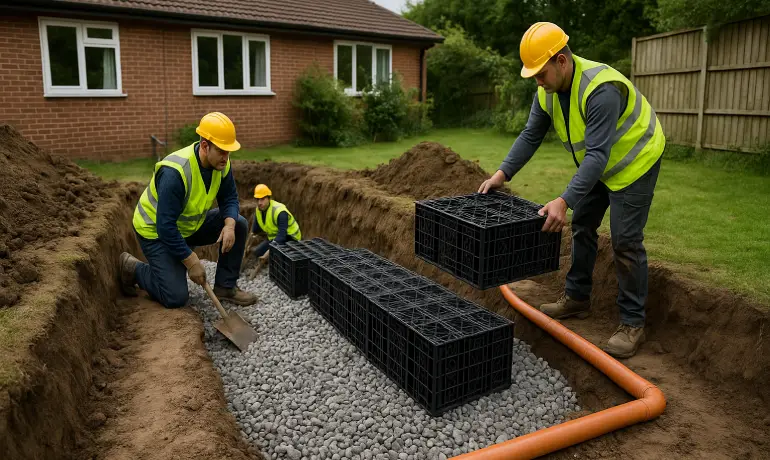Malcolm Spalding
The work was to make a sewer connection to one of our buildings. AFS were patient, helpful and professional throughout. Special thanks to Dan Ford and Steve for an excellent job.
Our ground drainage engineers design, install and repair high-performance soakaway systems across Hampshire. Whether you're dealing with garden flooding, pooling rainwater, a failed soakaway or surface water drainage issues, we install modern crate systems, traditional rubble soakaways and tailored infiltration solutions to manage excess water safely and effectively for homes, landlords and commercial clients.
Emergency Services & Enquiries
Real feedback from homeowners and businesses across Hampshire, Surrey & West Sussex.
Our fully accredited engineers are ready to assist 24/7.
Emergency Services & Enquiries

A correctly installed soakaway removes excess surface water, prevents pooling, protects foundations and stops gardens from becoming waterlogged. Our Hampshire team designs systems based on soil type, ground permeability and property layout, ensuring long-term performance.
We install a range of systems including crate soakaways, traditional rubble soakaways, linear drainage channels, French drains and full stormwater management solutions. If an existing soakaway has failed, we can diagnose the issue using CCTV, ground surveys and infiltration testing before replacing or upgrading the system.
In Hampshire, soakaway problems often arise from poor soil permeability, ageing systems, incorrect installation or increased rainfall. Common issues we resolve include:
All soakaway installations and repairs include full reporting, infiltration assessments and long-term drainage recommendations.
Our structured soakaway installation process ensures correct design, placement and long-lasting stormwater management:
All installations include documentation, infiltration results and guidance to keep your drainage system performing efficiently.
If your property is flooding, water is backing up, or your soakaway has completely failed, our engineers can inspect and restore your drainage system quickly.
We provide urgent soakaway and surface water drainage support across Winchester, Basingstoke, Alton, Farnham, Petersfield, Andover, Eastleigh, Liphook, Bordon and surrounding Hampshire areas.
Our soakaway services include new installations, crate systems, rubble soakaways, infiltration testing, drainage channels, French drains, CCTV diagnostics and full stormwater management.
All work is carried out by experienced drainage and groundworks engineers using approved installation methods and high-performance materials.
Our professional soakaway services support homeowners, landlords, rural estates, commercial sites and insurance providers across Hampshire.
To arrange soakaway installation or repairs in Hampshire, call 01420 561661 or complete our online form. Emergency appointments available.
ReliableProfessional24/7 Support